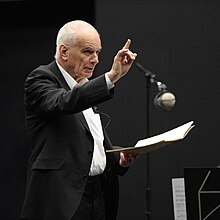|
Symphony No. 1 (Davies)
The Symphony No. 1 by Peter Maxwell Davies was composed between 1973 and 1976, and is dedicated to Sir William Glock, "as a mark of friendship and of appreciation of his work for contemporary music in his years as music controller at the B.B.C.".[1] It was commissioned by the Philharmonia Orchestra, which gave the premiere of the symphony at the Royal Festival Hall, London, on 2 February 1978, with Simon Rattle conducting. Character and materialsIn his First Symphony, Davies addresses both the Beethoven model of the symphony and Sibelius's reinterpretation of it.[2] Davies began work on what would become his First Symphony in 1973: a commission by the Philharmonia Orchestra intended to be performed the next year, resulting in a single-movement work of moderate length, provisionally titled Black Pentecost. However, the composer withdrew this score before it could be performed, feeling that it was not complete and needed to extend beyond the already-finished movement. In order to increase his understanding of large-scale orchestral composition, Davies analysed a number of other composers' works, and cites Sibelius's Fifth Symphony, the opening of Schumann's Second Symphony, and the first movement, "Don", from Pierre Boulez's Pli selon pli as precedents for specific moments of the composition. As the work evolved, Davies came to the conviction that it "could mark the possibility of a beginning of an orchestral competence", and so decided to designate it a Symphony. The pitches, note values, and longer time-spans are shaped and transformed by magic squares. Several plainsongs occur, and are transformed from one into another. The overall tonal centre is F, with a "modal dominant" of D♭.[3] InstrumentationThe symphony is scored for piccolo (doubling alto flute), two flutes (second doubling second piccolo), two oboes, cor anglais, two clarinets, bass clarinet, two bassoons, double bassoon, four horns, three trumpets, three trombones, timpani, four percussionists (playing marimba, tubular bells, flexatone, glockenspiel, and crotales), harp, celesta, and strings. AnalysisThe symphony is in four movements:
After brass and pizzicato strings introduce the basic harmonies of the movement, the symphony proceeds as an allegro movement with "a ghost of a sonata form somewhere behind it", though there are no distinct first and second themes, and development is replaced by processes of transformation.[4] The second movement is a lento that turns into a scherzo, beginning with a statement of the plainsong Ave maris stella in the alto flute. It has D as its tonic, and a modal dominant of F♯.[5] The third movement is the slow movement proper, and has as its tonic the previous movement’s modal dominant, F♯, and the corresponding modal dominant A♯/B♭ and becomes an invocation of the "extraordinary, almost unearthly, treeless winter land and seascape of the Orkney island" where the composer lives.[5] The finale parallels the tonal shape of the first. It reaches a climax with an emergence of the "Ave maris stella" material in the form found in Davies's composition of the same title.[6] The silences broken by jabbed chords at the end of the movement refers to the endings of the Fifth Symphonies of both Beethoven and Sibelius. The relationship to Beethoven is expressed exclusively in terms of rhythm.[7] Discography
References
Sources
Further reading
|
||||||||||||||||||||||||
